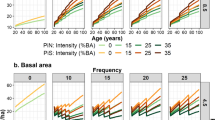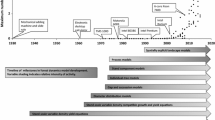Abstract
Thinning strategies are a prime factor in generating spatial patterns in managed forests, and have a dramatic effect on stand development, and hence product yields. As trees generally have long life spans relative to the length of typical research projects, the design and analysis of complex long-term spatial–temporal experiments in forest stands is clearly difficult. This means that forest modelling is a key tool in the formulation and development of optimal management strategies. We show that the highly flexible Renshaw and Särkkä algorithm for modelling the space–time development of marked point processes is easily adapted to enable the comparative study of different thinning regimes. This procedure not only provides a powerful descriptor of forest stand growth, but there is considerable evidence that it is particularly robust to the accuracy of model choice. Two distinct thinning approaches are considered in conjunction with a variety of tree growth functions and both hard- and soft-core interaction functions. The results obtained strongly suggest that combining the immigration–growth–spatial interaction model with spatially explicit thinning algorithms produces a realistic and flexible mechanism for mimicking real forest scenarios.



Similar content being viewed by others
References
Banks RB (1994) Growth and diffusion phenomena. Springer, Berlin
Bella IE (1971) A new competition model for individual trees. For Sci 17:364–372
von Bertalanffy L (1949) Problems of organic growth. Nature 163:156–158
Chapman DG (1961) Statistical problems in dynamics of exploited fisheries populations. In: Proceedings of the 4th Berkeley symposium on mathematics, statistics and probability. University of California Press, Berkeley
Comas C (2005) Modelling forest dynamics through the development of spatial and temporal marked point processes. University of Strathclyde, Ph.D. thesis (unpublished)
Comas C, Mateu J (2006) Spatial clustering based on structured parent configurations: a perspective from reproducing individuals. Technical report 111, Universitat Jaume I, Castellon, Spain
Courbaud B, Goreaud F, Dreyfus Ph, Bonnet FR (2001) Evaluating thinning strategies using a tree distance dependent growth model: some examples based on the CAPSIS software “uneven-aged spruce forests” module. For Ecol Manage 145:15–28
Cressie NAC (1993) Statistics for spatial data (revised edition). Wiley, New York
Degenhardt A (1999) Description of tree distribution and their development through marked Gibbs processes. Biomet J 41:457–470
Diggle PG (2003) Statistical analysis of spatial point patterns. Arnold, London
Ek AR, Monserud RA (1974) FOREST: a computer model for simulating the growth and reproduction of mixed-species forest stands. Research paper, R2635. University of Wisconsin
Ferguson ER (1963) Overstory density key to pine seedling survival and growth in East Texas. J For 61:597–598
Ford ED, Renshaw E (1984) The interpretation of process from pattern using two-dimensional spectral analysis: modelling single species patterns in vegetation. Vegetation 56:113–123
Fritts HC (1976) Tree-ring and climate. Academic Press, New York
Gerrard DJ (1969) Competition quotient—a new measure of the competition affecting individual forest trees. Michigan State University Agricultural Experimental Station Research Bulletin, no. 20
Gracia CC, Burriel JA, Ibànez JJ, Mata T, Vayreda J (2003) Inventari Ecològic Forestal de Catalunya, 9. Bellaterra: CREAF
Hart HMJ (1928) Stamtal en Dunning–een Orienteerend Onderzoek naar de Beste Plantwijdte en Dunningswijze voor den Djati. Venman and Zonen, Wageningen
Hasenauer H (1994) Ein Einzelbaumwachstumssimulator für ungleichaltrige Fichten-Kiefern- und Buchen-Fichtenmischbestde. Forstliche Schriftenreihe der Universitä für Bodenkultur. Wien. Band 8, 152 pp
Hasenauer H, Moser M, Eckmüllner O (1995) MOSES: a computer simulation program for modelling stand response. In: Pinto da Costa ME, Preuhsler T (eds) Mixed stands, research plots, and results, models. Instituto Superior De Agronomia, Universidade Tecnica de Lisboa, Portugal
Hawkes AG (1971a) Spectra and some self-exciting and mutually exciting point processes. Biometrika 58:83–211
Hawkes AG (1971b) Point spectra of some mutually exciting point processes. J R Stat Soc B 20:1–43
Hawkes AG (1972) Spectra of some mutually exciting point processes with associated variables. In: Lewis PAW (ed) Stochastic point processes. Wiley, New York, pp 261-271
Henderson R, Ford ED, Renshaw E, Deans JD (1983a) Morphology of the structural root system of Sitka Spruce. 1 Analysis and quantitative description. Forestry 56:121–135
Henderson R, Ford ED, Renshaw E (1983b) Morphology of the structural root system of Sitka Spruce. 2 Computer simulation of rooting patterns. Forestry 56:137–153
Kellomäki S, Nevalainen T (1983) On relationship between stand density and tree size. Silva Fennica 17:389–402
Lei YC, Zhang SY (2004) Features and partial derivatives of Bertalanffy–Richards growth model in forestry. Nonlinear Anal Modell Control 9:65–73
Mateu J, Usó JL, Montes F (1998) The spatial pattern of forest ecosystems. Ecol Modell 108:163–174
Matis JH, Kiffe TR, Matis TI, Stevenson DE (2007) Stochastic modeling of aphid population growth with nonlinear, power-law dynamics. Math Biosci 208:469–494
Matis JH, Kiffe TR, Parthasarthy PR (1998) On the cumulants of population size for the stochastic power law logistic model. Theor Popul Biol 53:16–29
Monserud RA, Sterba H (1996). A basal area increment model for individual trees growing in even-and uneven-aged forest stands in Austria. For Ecol Manage 80:57–80
Ojansuu R, Hynynen J, Koivunen J, Luoma P (1991) Luonnonprosessit metsälaskelmassa (MELA)- Metsä 2000-versio. Finnish Forest Research Institute Vantaa. Research paper 385
Oliver CD, Larson BC (1996) Forest stand dynamics. Wiley, New York
Pacala SW, Canham CD, Silander JA (1993) Forest models defined by field measurements: I. The design of a northeastern forest simulator. Can J For Res 23:1980–1988
Penttinen A, Stoyan D, Henttonen HM (1992) Marked point processes in forest statistics. For Sci 38:806–824
Pienaar LV, Turnbull KJ (1973) The Chapman–Richards generalization of von Bertalanffy’s growth model for basal area growth and yield in even-aged stands. For Sci 34:804–808
Pretzsch H (1992) Konzeption und Konstruktion von Wuchsmodellem für Rein- und Mischbestände. Schriftenreihe d. Forstw. Fak. Univ. München, No. 115, 332 pp
Pretzsch H, Biber P, Ďursk J (2002) The single tree-based stand simulator Silva: construction, application and evaluation. For Ecol Manage 162:3–21
Prévosto B, Curt T, Gueugnot J, Coquillard P (2000) Modelling mid-elevation Scots pine growth on a volcanic substrate. For Ecol Manage 131:223–237
Pukkala T, Miina J (1998) Tree-selection for optimizing thinning using a distance-dependent growth model. Can J For Res 28:693–702
Pukkala T, Kolström T, Miina J (1994) A method for predicting tree dimensions in Scots pine and Norway spruce stands. For Ecol Manage 65:123–134
Pukkala T, Miina J, Kurttila M, Kolström T (1998) A spatial yield model for optimizing the thinning regime of mixed stands of Pinus sylvestris and Picea abies. Scand J For Res 13:31–42
Rathbun SL, Cressie N (1994) A space–time survival point process for a Longleaf pine forest in Southern Georgia. J Am Stat Assoc 89:1164–1174
Raulier F, Pothier D, Bernier PY (2003) Predicting the effect of thinning on growth of dense balsam fir stands using a process-based tree growth model. Can J For Res 33:509–520
Renshaw E (1984) Competition experiments for light in a plant monoculture: an analysis based on two-dimensional spectra. Biometrics 40:717–728
Renshaw E (2002) Two-dimensional spectral analysis for marked point processes. Biomet J 44:718–745
Renshaw E, Ford ED (1983) The interpretation of process from pattern using two-dimensional spectral analysis: methods and problems of interpretation. Appl Stat 32:51–63
Renshaw E, Särkkä A (2001) Gibbs point processes for studying the development of spatial–temporal stochastic processes. Comput Stat Data Anal 36:85–105
Richards FJ (1959) A flexible growth function for empirical use. J Exp Bot 10:290–300
Särkkä A, Renshaw E (2006) The analysis of marked point patterns evolving through space and time. Comput Stat Data Anal 51:1678–1718
Särkkä A, Tomppo E (1998) Modelling interactions between trees by means of field observations. For Ecol Manage 108:57–62
Smith DM, Larson BC, Kelty MJ, Ashton PMS (1997) The practice of silviculture; applied forest ecology. Wiley, New York
Staebler GR (1951) Growth and spacing in an even-aged stand of Douglas-fir. Master’s thesis. University of Michigan
Stage AR (1973) Prognosis model for stand development. USDA Forest Service Research. Paper INT-137
Sterba H, Monserud RA (1997) Applicability of the forest stand growth simulator PROGNAUS for the Austrian part of the Bohemian massif. Ecol Modell 98:23–34
Stoyan D, Kendall WS, Mecke J (1995) Stochastic geometry and its applications. Wiley, New York
Teck R, Moeur M, Eav B (1996) Forecasting ecosystems with the forest vegetation simulator. J For 94:7–10
Tomppo E (1986) Models and methods for analysing spatial patterns of trees. Communicationes Instituti Forestalis Fenniae 138
Wahlenberg WG (1960) Loblolly pine. School of Forestry, Duke University
Wykoff WR, Crookston NL, Stage AR (1982) User’s guide to the stand Prognosis model. USDA Forest Service General Technical Report INT-133
Zeide B (1993) Analysis of growth equations. For Sci 39:594–616
Author information
Authors and Affiliations
Corresponding author
Rights and permissions
About this article
Cite this article
Renshaw, E., Comas, C. & Mateu, J. Analysis of forest thinning strategies through the development of space–time growth–interaction simulation models. Stoch Environ Res Risk Assess 23, 275–288 (2009). https://doi.org/10.1007/s00477-008-0214-x
Published:
Issue Date:
DOI: https://doi.org/10.1007/s00477-008-0214-x




